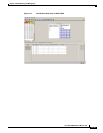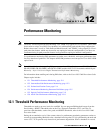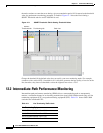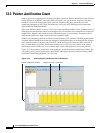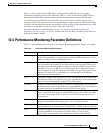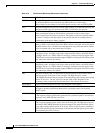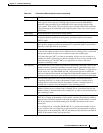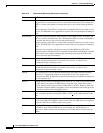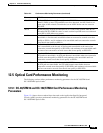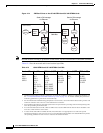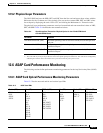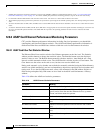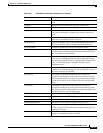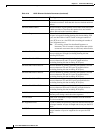
12-7
Cisco ONS 15600 Reference Manual, R7.2
Chapter 12 Performance Monitoring
12.4 Performance-Monitoring Parameter Definitions
OPR Optical Power Received (OPR) is represented by the percentage of the normal optical
receive power of the card port. The high optical power received (OPR-HIGH)
threshold is the percentage of the calibrated receive optical power when a high
receive power TCA occurs. The low optical power received (OPR-LOW) threshold
is the percentage of the calibrated receive optical power when a low receive power
TCA occurs.
PPJC-PDET Pointer Justification STS Detected (PPJC-PDET).
PPJC-PDET-P Positive Pointer Justification Count, STS Path Detected (PPJC-Pdet-P) is a count of
the positive pointer justifications detected on a particular path in an incoming
SONET signal.
PPJC-PGEN-P Positive Pointer Justification Count, STS Path Generated (PPJC-Pgen-P) is a count
of the positive pointer justifications generated for a particular path to reconcile the
frequency of the SPE with the local clock.
PSC (1+1) In a 1+1 protection scheme for a working port, Protection Switching Count (PSC) is
a count of the number of times service switches from a working port to a protection
port plus the number of times service switches back to the working port.
For a protection port, PSC is a count of the number of times service switches to a
working port from a protection port plus the number of times service switches back
to the protection port. The PSC PM is only applicable if revertive line-level
protection switching is used.
PSC (BLSR) For a protect line in a two-fiber ring, Protection Switching Count (PSC) refers to the
number of times a protection switch has occurred either to a particular span’s line
protection or away from a particular span's line protection. Therefore, if a protection
switch occurs on a two-fiber BLSR, the PSC of the protection span to which the
traffic is switched will increment, and when the switched traffic returns to its original
working span from the protect span, the PSC of the protect span will increment again.
PSC-R In a four-fiber bidirectional line switched ring (BLSR), Protection Switching
Count-Ring (PSC-R) is a count of the number of times service switches from a
working line to a protection line plus the number of times it switches back to a
working line. A count is only incremented if ring switching is used.
PSC-S In a four-fiber BLSR, Protection Switching Count-Span (PSC-S) is a count of the
number of times service switches from a working line to a protection line plus the
number of times it switches back to the working line. A count is only incremented if
span switching is used.
PSC-W For a working line in a two-fiber BLSR, Protection Switching Count-Working
(PSC-W) is a count of the number of times traffic switches away from the working
capacity in the failed line and back to the working capacity after the failure is cleared.
PSC-W increments on the failed working line and PSC increments on the active
protect line.
For a working line in a four-fiber BLSR, PSC-W is a count of the number of times
service switches from a working line to a protection line plus the number of times it
switches back to the working line. PSC-W increments on the failed line and PSC-R
or PSC-S increments on the active protect line.
Table 12-2 Performance Monitoring Parameters (continued)
Parameter Definition



